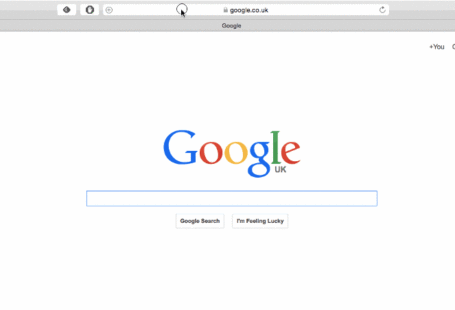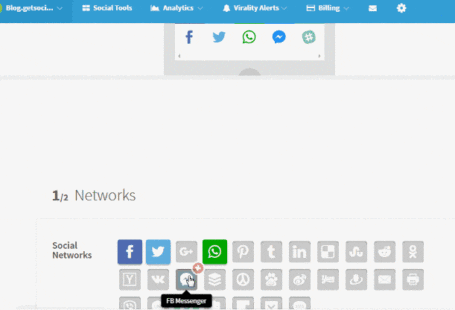A link to the future
Recently, I reflected about the fundamental flaws of UTM codes.
It was under the impression that “UTM codes (were) a mandatory tool for professionals working with social media or traffic analysis.” I wasn’t very far from the truth. A few weeks ago, we surveyed our customers and some select industry professionals. Not one person mentioned they did not use parameters when crafting links. Also, the big majority combined the usage of parameters with a shortening service.
The reason they were using shortener and parameters was to “know the performance of each link”, an option followed by all respondents.
I must say, I was surprised at these absolute responses: 100% here, 100% there. Too good not to do something about it, right?
To be honest, this wasn’t (just) any survey. It was a product discovery survey, something that we do before developing a new feature. The results of the survey empowered us to build what I hereby announce as our Social Link Analyzer.
Before moving into screenshots and available data, let me contextualize for a moment.
The reason this has been creating such a stir is because digital & social marketers have been expecting this for a while now.
At GetSocial, we started writing about Dark Social early in 2015. We knew Social was changing and we wanted to lead that change, from an analytics standpoint.
Soon enough, we developed the technology that now helps companies like Adobe, Sky, and Forbes understand how their audience shares and engages with content in private channels such as WhatsApp, Facebook Groups, Facebook Messenger, Slack, Email and others.
However, we kept observing our customers maintaining obsolete processes on distributing their content online. Social, Email, Paid. All these channels were still managed by a legacy process:
- Take a link
- Place some tracking parameters on it
- Shorten the link
- Distribute
- Report
- Rinse and repeat
As explained before, this process is utterly misaligned with today’s digital & social behaviors. By using static parameters such as UTMs, marketers are actually making their job more difficult as they’re compromising their data every step of the way.
The problems they create to themselves follow a cycle, something I’ve called the UTM fallacy.
UTM Fallacy: the belief that all incoming traffic from predefined UTMs is accurate, valid and changeless.
If our analytics platform defines this session coming from “Facebook Post” medium, this should be an immutable truth. Truth be told, this couldn’t be further from reality.
And here’s how the fallacy unfolds:
- You distribute our new shortened link. The moment someone shares it through copy paste to a different channel, you’re done. The misattribution begins.
- Your “UTM Source = Facebook” link gets shared onto Telegram. Someone clicks on it. Facebook gets a +1 session on your analytics platform. Misattributed traffic increases.
- You do your weekly reporting and after thousands of interactions, Facebook is the clear champion. Your team decides to invest more distributing that link. Misattributed success knocks on your door.
- Another week has passed and you’re in the same meeting discussing how/why last week’s investment didn’t go as well as planned. Traffic was too costly as you were expecting a lot more earned traffic from your link. Misattributed investments ensue.
- The week is over. You ended up with limited visibility on your link’s performance, spent money and you’re still undecided if the campaign was a success or not. The fallacy lives onto the next link.
How do we fix this? How do we work towards a better attribution model for Social? One that fits our behaviors. One that works!
The answer comes in the form of a cycle too. A simpler one:
- Fix measurement: considering all channels, public or private
- Analyze at depth: there’s more to a link that the first click
- Proper Social Attribution Model: where you see all the owned and earned traffic of your links
Let’s get phys… visual then. Here’s how the feature works.
The story starts like it always does: by creating a link. It’s as simple as it gets. Just paste your long URL where you’re asked to and we’ll take care of the rest.
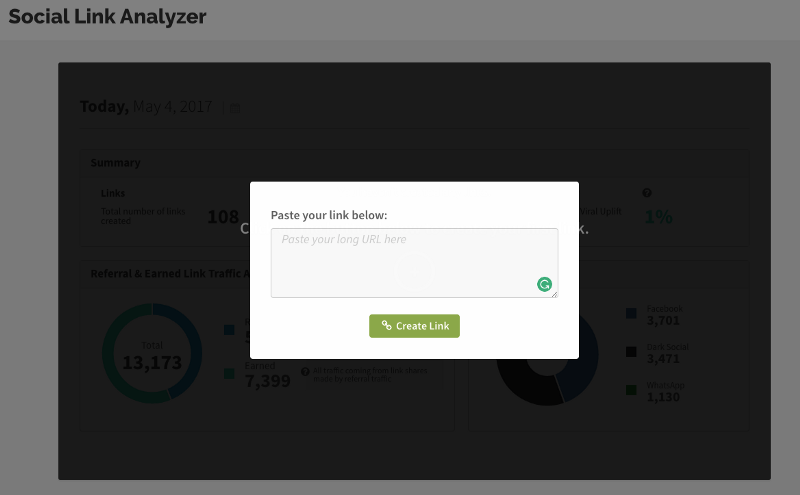
Now, the magic starts to show. Once you distribute your links, you’ll start to see stuff happening on this dashboard. By the way, did I mention this is real-time data?
This page holds two sections: a summary dashboard and a link detailed view.
The summary dashboard looks as follows:
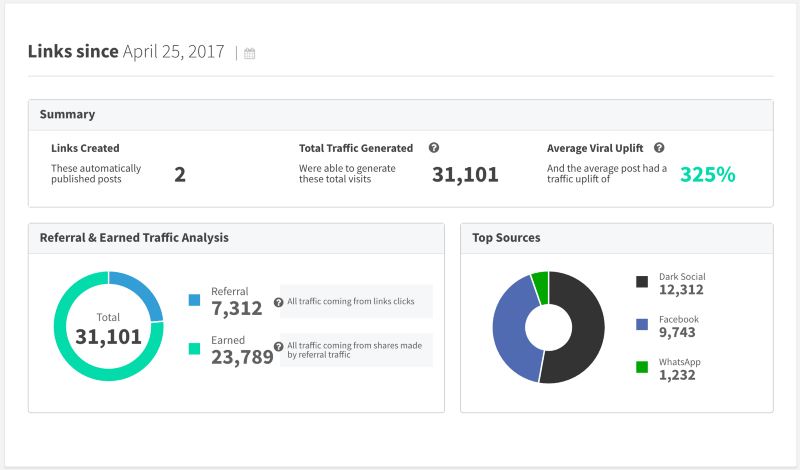
The story we tell here is simple: your x number of links were able to generate a total of y traffic. Some of that traffic was referral some was earned.
There’s a clear way to explain the difference between a referral and earned traffic.
Imagine you shorten your URL and send an email to your team with it. Everyone who opens the email and clicks on the link will be considered referral traffic.
Sophia was one of your colleagues who clicked the link you sent. She found its content so interesting that she decided to share it with John. Sophia was also on her iPhone when she opened the link so she just browser-shared the page to John’s WhatsApp.
John’s phone vibrated. A WhatsApp message from Sophia with a link that he promptly opened. Because he opened a link from a share, John is an earned session by the original link. Something that went past the first level of interaction and developed by the organic sharing power of the initial audience.
Replicate this a few times and this is what you’ll get.
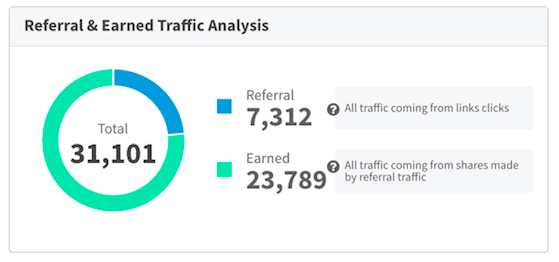
A full scope of how much referral and earned traffic and, also, the main traffic sources of such visits.
Now, you know something worked for you but you had created a few links. Which one actually worked best? Which one was the driver of so much earned traffic?
If this is on your mind, then it’s time to scroll down and look at the link detail analytics. Here, we provide you with all the data presented above, at the link level.
You can see the clear winner here.
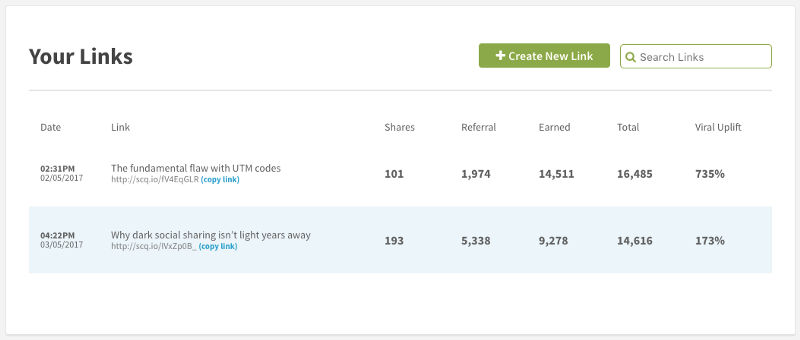
Wrap up
If you lasted thus far, I salute you. You now have a complete understanding of how the feature and its attribution model work.
Next steps? Quite simple:
– if you want our opinion on how this could help or want a tailored demo to your business, send us a message to sales@getsocial.io
– if you’re ready to try this out, feel free to start a GetSocial free trial and unleash your new Social Links!
Interested in knowing more about Dark Social & Analytics?
[su_button url="https://getsocial.io" target="_blank" style="flat" background="#21D2B5" color="#ffffff" size="7" wide="no" center="yes" radius="auto" icon="" icon_color="#FFFFFF" text_shadow="none" desc="" onclick="" rel="" title="" id="" class=""]SIGN UP FOR FREE[/su_button]



